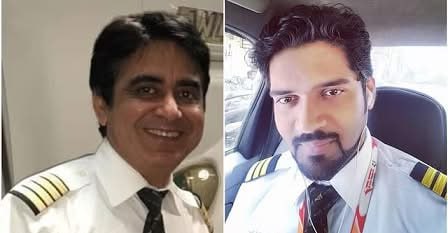
A haunting cockpit voice recording has revealed a dramatic exchange between the two pilots of the Air India flight that crashed shortly after takeoff last month, claiming over 241 lives.
The Aircraft Accident Investigation Bureau (AAIB) of India released a preliminary report detailing what transpired on board the London-bound aircraft that went down on June 12, 2025, in Gujarat’s Meghani Nagar district.
According to the report, one of the last recorded conversations in the cockpit was a startled question:
“Why did you cut off the fuel?”
To which the other pilot urgently replied:
“I didn’t.”
This exchange, heard moments after the pilots had declared an emergency to air traffic control, is shedding new light on the possible cause of the devastating crash.
“Thrust not achieved… falling… Mayday! Mayday! Mayday!” one of the pilots radioed moments before the aircraft plunged from a low altitude of 625 feet into a densely populated area, including part of the BJ Medical College hostel.
Startling Clues Suggest Manual or Malfunction-Induced Fuel Cutoff
Investigators say the plane’s engines were suddenly starved of fuel mid-ascent. Both engine fuel cutoff switches were found to have flipped from RUN to CUTOFF within one second of each other. Aviation experts say such switches are heavily guarded against accidental activation.
“You can’t bump them and they move. Accidental engagement is extremely rare,” said John Cox, a U.S.-based aviation safety expert.
Despite the suspicious sequence, forensic analysis confirmed that the fuel switches were in the RUN position upon impact, and the thrust levers were still set forward — suggesting the pilots were trying to keep the aircraft powered.
Still, CCTV footage from the airport showed the Ram Air Turbine — an emergency power system — deploying shortly after takeoff, indicating a catastrophic power failure.
Mechanical or Sabotage? Investigators Probe Deeper
With no mechanical faults found in the aircraft or its General Electric engines, and with 54,200 kg of verified good-quality fuel onboard, investigators are now looking at the aircraft’s electronic control unit. There’s growing speculation that the fuel cutoff might have been triggered remotely or through a fault in the aircraft’s complex systems.
Capt. Kishore Chinta, a former AAIB investigator, questioned whether an unseen technical fault might have electronically tripped the cutoff switches: “We need to ask if there was any override from the electronic control unit that bypassed manual pilot control.”
Experienced Crew, No Survivors — Except One
The flight was manned by seasoned professionals: Captain Sumeet Sabharwal with over 10,000 flying hours and Co-pilot Clive Kunder with more than 3,400 hours. Both were cleared in pre-flight checks and deemed fully rested.
Tragically, the crash claimed the lives of all passengers and crew onboard, as well as 19 people on the ground — with the sole survivor being a British national who unhooked his seatbelt and escaped through a tear in the fuselage.
As the full investigation continues, families and experts alike are demanding clarity on how a modern jetliner could suffer such a sudden and total loss of power — and whether human error, sabotage, or a rare technical anomaly is to blame.











